Fist Full of Flutes, Trios, Vol. 1
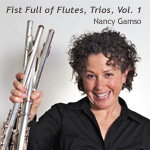
These trios for three C flutes are appropriate for developing to intermediate flutists and also work well for casual classical gigs, sight-reading and adult amateurs. Three are published alone and the rest are from the Rubank publication, Chamber Music for Three Flutes. The style ranges from Baroque (Bach, Corelli, Handel) to early American (arr. of Cohan). Complete publishing information can be found below.
Tracks for each piece below are available separately as high-quality mp3 files.
Or, download the entire set (single zip file): Flute-Trios-Vol.-1
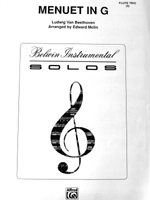
Beethoven, Ludwig van; McLin, Edward, arranger; Menuet in G, Alfred Pro Art Pub. Pro Ens 57
Ludwig van Beethoven (1770-1827)is probably best known for his famous Fifth Symphony and his unfortunate deafness. In 18th century Vienna, he was one of a long line of famous musicians, including Mozart, Haydn, Schubert, Brahms and many others. Beethoven wrote one opera and several choral works but mostly he wrote instrumental music. Folks who think about these things have noticed that his early works strongly resemble those of Mozart and Haydn (Beethoven’s Period of Imitation), Ludwig’s young adult music has a bold spirit (his Heroic Style Period), and his late-in-life compositions are more reflective (the Period of Introspection). What I have often wondered is why is it that Ludwig van Beethoven’s music seems to be the first of many composers to be so very closely related to his personal life story. I’ve come to believe that perhaps it is because he was the right person to come along at the right time – a true tragic and phenomenally talented character, born at the cusp of the most overtly emotional era of classical music history, the 19th century Romantic Era.Music historians define “Romantic” rather different than we might in the 21st century. Romanticism in the 1800s encompassed tragedy, heartbreak, revolution, death, madness and, oh yes, occasionally love but usually tragically so. Ludwig, for his personal romanticism, had an emotion-filled existence. He came very close to having the opportunity to study with Mozart in Vienna but just before the first lessons, Ludwig was call home to take care of his dying mother. He suffered the fate of many abused oldest children by both taking the brunt of the abuse and becoming the defender/caretaker of his mother and younger brothers. He proposed to several women whose fathers thought Ludwig did not have the proper pedigree. He was even in Vienna when it was bombed (technically “cannon-balled”) by Napoleon’s army. Finally, the greatest tragedy – he lost his hearing just a few years after becoming a wildly popular pianist favored by Viennese aristocrats. Really, the guy couldn’t win! Except for the fact that through it all, Beethoven was able to compose some of the most beautiful music ever written. Read more about Beethoven if you love a good story. There is a compelling movie that illustrates his life, with some fictional license, titled Immortal Beloved and a wonderful audio children’s story in the Classical Kids series, Mr. Beethoven Lives Upstairs. Check them out, he’s quite a character.
The Minuet in G, WoO (acronym for Without Opus number) 10, No. 2is one of those works that Beethoven wrote as a boy, back in his hometown of Bonn, before he became a big shot in Vienna (and started using official opus numbers). This is possibly his most popular early work, and a staple of most young musician piano recitals. It was originally a movement from a suite of dances for orchestra, but that version has been lost.Now, how to approach this piece: think, feel or even move to this piece, as if your trio is accompanying dancers. It is a gentle and supple melody that seems to ask for time to glide, hesitate, tiptoe and finally rest. Listen to my recording and see if you can tell just where I was choreographing the dancers in my imagination of gliding, hesitating, tiptoeing and resting.
01-Beethoven, Menuet in G, complete version
02-Beethoven, Menuet in G, minus 1st part
03-Beethoven, Menuet in G, minus 2nd part
04-Beethoven, Menuet in G, minus 3rd part
Download all four tracks (single zip file)
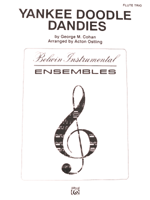
Cohan, George M.; Ostling, Acton, arranger; Yankee Doodle Dandies; Alfred, Belwin Mills Pub., F.D. Ens. 1-7
George M. Cohan (1878 – 1942) has a great story. With his mom, dad and sister, George spent his childhood and his most of his adult life as “The Four Cohans,” a family song and dance act on the vaudeville circuit. (Vaudeville is the name given to traveling variety shows, all the entertainment rage in the early 20th century before radio stole the show, literally.) George added his wife Ethel to the act as soon as they were married. (Makes you wonder if he auditioned several girls for the role of the fifth Cohan.) George and his singing, dancing family made it big on Broadway as well, performing George’s musicals. George wrote the story, the music and the lyrics – usually the job of three folks – and don’t forget that he was still dancing, singing and acting in these productions.The two songs in this publication come from two different Broadway shows, “Yankee Doodle Dandy” comes from a 1904 show, Little Johnny Jones, which was wildly popular and is considered by some to be the first true American Broadway show. You might wonder how Broadway musicals would not be truly American. This is because Little Johnny Jones was one of the first that didn’t resemble the shows from Europe and as well, it was awash in American flag waving and a story about honest, good American values. Curiously, it was such a good story that it was made into not one, but two silent films. The second song in this flute trio arrangement is “Mary’s a Grand Old Name”, from the very next musical that George Cohan wrote and produced, Forty Five Minutes from Broadway. Who was Mary, you may ask? She was the housekeeper that the romantic guy, Tom, falls for (instead of his fiancée actress), even before he finds out that Mary has inherited millions from his own uncle – another great American love story.
If you listen to an early recording of “Yankee Doodle Dandy,” you’ll notice the jaunty character in the melody. Try to emulate this style. I added a ritardando, two measures before J and put the new tempo at the pickups to J. Incidentally, B is the beginning of the “Yankee Doodle Dandy” tune and J is the tune “Mary’s a Grand Old Name”, as indicated in the score but not the parts. You may notice where I take breaths in the melody, 1st and 2nd parts. I was going for a more natural melodic line, so sometimes the breaths are less frequent or before a bar line.
05-Cohan, Yankee Doodle Dandies, complete version
06-Cohan, Yankee Doodle Dandies, minus 1st part
07-Cohan, Yankee Doodle Dandies, minus 2nd part
08-Cohan, Yankee Doodle Dandies, minus 3rd part
Download all four tracks (single zip file)
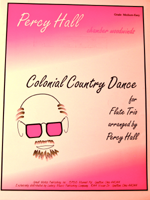
Hall, Percy, Colonial Country Dance, Great Works Pub., 00459
Percy Hall (b. circa 1930) is a retired music teacher from Mansfield, Ohio and a retired adjunct professor of Ashland University. As a member of the Mansfield Symphony he formed a woodwind trio that performed school concerts in the Mansfield public schools. I was on the tour one year and it was a trip. One school had twenty or so hearing-impaired students and they all sat in the front row, some gently touching the bells of our clarinets to feel the vibrations as we played. I interviewed Percy about this work and the clarinet trio that I recorded and he had this to say about them: “I arranged these folk tunes (or composed in the style of a folk tune, as with this trio) because children were no longer singing these great American folksongs and because at the time I was a band director and was disturbed at the lack of appropriate literature for small ensembles.” At 80+ years young, Mr. Hall is still excited about composing and arranging music as well as advocating for music education. You can visit his vast selection of publications
here.
The aspect about this selection that catches the listener’s attention is the contrast in style from the bright, optimistic opening dance in F major to the lyrical, velvety d minor interlude at m. 17. Pay close attention to the style of the articulation in both sections – from spaced and accented notes to long and connected ones. I’ve taken out the breaths in mm. 18 and 22, as I believe that it makes for a nicer line. As well, the breath at m. 30 – I don’t think you will need it and it makes for a more dramatic crescendo.I’ve taken out the poco rit at m. 49, but I can see how it can work as a kind of cheeky, coy gesture by the dancers, so try it and see if you want it. The ‘slap’ is a bit tricky when you are standing up, so maybe the 1st player, whose right hand isn’t playing notes could slap the leg while the others do their right shoulder? Get creative! As long as the rhythm is correct, it should work.
09-Hall, Colonial Country Dance, complete version
10-Hall, Colonial Country Dance, minus 1st part
11-Hall, Colonial Country Dance, minus 2nd part
12-Hall, Colonial Country Dance, minus 3rd part
Download all four tracks (single zip file)
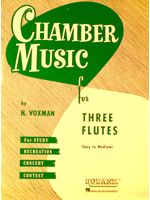
Voxman, H., editor; Chamber Music for Three Flutes (Easy to Medium), Rubank, Hal Leonard, HL04474540
Bach, Chorale
Johann Sebastian Bach (1685-1750) You’ve no doubt heard a few interesting tidbits about the most famous member of the Bach family, so I’ll just include a few of my own that might be of interest to flute folk. In J.S. Bach’s time, the flute was made of wood, usually boxwood, and had one key, the right pinkie ‘E-flat’. He wrote six sonatas for flute and has a couple others credited to him, but it’s thought that these others were written by someone else, probably one of his many musical sons. He also wrote many other works that included flute – concerti, obbligato flute with voice and accompaniment – so flutists have a lot of Bach to play. Although now we think of J.S. Bach as a musical genius, at the end of Bach’s life, his music was considered old fashioned. At that time, anything written in the past was not considered worthy of listening or performing, such was the way with contemporary music, similar to today’s attitudes towards popular music. It wasn’t until the 19th century (1800s) that another German composer, Felix Mendelssohn revived J.S. Bach’s image, having Mendelssohn’s famous GewandhausOrchestra performed Bach’s works in concerts, along with new music that Mendelssohn and his friends had composed. As a result of Mendelssohn’s homage, Bach’s reputation was restored and has held up pretty well ever since.This chorale was thought to have been written in 1707. Christ lag in Todesbanden is a church cantata based on a tune by Martin Luther. The original tune is included in all seven movements of the cantata, a seldom found practice in the Lutheran cantata tradition.
Even if you don’t use this chorale for contest, it makes a brilliant warm up and ensemble tuning exercise. Therein lie opportunities to tune octaves, 5ths and major/minor 3rds – all in the key of d minor. You may even hear difference tones, which are literally the tones derived from the difference of one tone’s vibrations per second (vps) minus a second tone’s vps. The 1st and 2nd players will especially hear them and the 3rd player will as well, when sounding notes are in the middle register. Note that the last measure features a typically flat note (low D) in the 3rd part and a typically sharp note in the 1st and 2nd parts (middle D). Use your head position and air direction to correct the pitches. (Look for my video on flute intonation, coming soon).Regarding the use of vibrato – terminal vibrato, less vibrato, straight tone – experiment with what sounds good to you. You may find that no vibrato on the unisons sounds interesting and would be in the style of the singers’ performance in Bach’s day. You may also find that no vibrato in the 2nd and 3rd parts and a bit in the 1st – either initial vibrato, terminal vibrato and only a little at that – sounds interesting as well. For more on vibrato, watch my expressive vibrato video.When considering what you want to do with the fermati (that’s plural for fermata), and the phrasing – notice how I played with different fermati time lengths and the pacing approaching them. I categorized the fermati on my music as ‘very short’, ‘short’, ‘long’ and ‘very long’. Notice that the one in m. 10 is the shortest, since the melody seems to want to move forward. Contrastingly, the very last one is the longest for a sense of finality.
13-Bach, Chorale, Chamber Music for 3 Flutes, complete version
14-Bach, Chorale, Chamber Music for 3 Flutes, minus 1st part
15-Bach, Chorale, Chamber Music for 3 Flutes, minus 2nd part
16-Bach, Chorale, Chamber Music for 3 Flutes, minus 3rd part
Download all four tracks (single zip file)
Corelli Adagio
Arcangelo Corelli (1653-1713) When we study Corelli we find a composer, teacher and music director who made a virtue of discipline when it came to teaching his violin students and ensembles – so much so that his techniques provided the model for other teachers. He also made an entire career as a composer writing only instrumental music and only in the forms of solo sonatas, trio sonatas and concertos.It’s interesting that once you see the original music, you understand why a trio sonata is played by four musicians – it’s all a perspective thing – the publisher is marketing three parts, it’s just incidental that the bottom line requires three hands to perform (the bass player’s two and the keyboard player’s left one, if you couldn’t figure that out). The bottom line of the trio was to be played by any bass instrument (usually cello) and a chording instrument (usually harpsichord). The chording instrument player would use the figured bass symbols to determine which chords to play. Here’s the
website and page where you can find this movement. Click on the web link, then under Image Files (Scores) choose Complete Score #01672. It is a pdf of
Sonata No. 3, Op. 2. The Adagio is found on p. 7, it is in a 3/2 time signature and in a different key but otherwise it’s the same one. You will see the figured bass/chord symbols below the bass line.
This short movement packs a lot of great chamber music lessons into a few minutes. For intonation, blend and balance, the octaves at the cadence points (mm. 9, 11, 21& 28) are great for these elements. You might try playing these without vibrato or just a little vibrato in the 1st part. I have a video on vibrato, if you require some insight! Throughout this work are places where the harmony is using major chords (as in the 1st full measure count 3 or in the last measure), minor chords (lots of chords throughout) and suspensions/resolutions (when two notes in the chord are a step apart, then move to a 3rd apart, as in mm. 5-7). The chords are interesting to tune – generally the 3rd in minor chords are played a bit sharp, 3rd in major chords are played a bit flat in order for the chords to ring in tune to our ears. Of course complicating all this tuning are the facts of flute playing: low range and quiet dynamics are generally flat, high range and loud dynamics are generally sharp. If you don’t have a teacher to show you, look for my video on flute intonation, coming soon.
17-Corelli, Adagio, Chamber Music for 3 Flutes, complete version
18-Corelli, Adagio, Chamber Music for 3 Flutes, minus 1st part
19-Corelli, Adagio, Chamber Music for 3 Flutes, minus 2nd part
20-Corelli, Adagio, Chamber Music for 3 Flutes, minus 3rd part
Download all four tracks (single zip file)
Johann Christoph Faber (1669-1744), Bourée from the Partita in F
Johann Christoph Faber (1669-1744) Johann Christoph was a German court composer who amused himself and his friends by embedding puzzles in his music, although I didn’t find any in this piece. The word “Partita” has at various times been used to mean simply a piece of music, a variation, or a collection of different pieces. This bourée for flutes and the March and two Minuets in the clarinet trios, volume 1 recording, would have been just the type of music a court composer might write for various courtly events. I have the 1960 Nagels Musik-Archiv edition and can see that this work is actually in C, not F and was composed originally for three recorders. A manuscript of the parts, which according to the 1960 edition, was kept in the Wolfenbüttel library and had “J.C.F.” indicated as the composer. I assume that it remains there today. Nagels Verlag has identified the “J.C.F.” on this one as Johann Christoph Faber and dates the work from around 1730. My colleague at Ohio Wesleyan, Dr. Tim Roden, tells me that the Wolfenbüttel library in Germany holds a number of rare and culturally important manuscripts.
This is a great beginning work for teaching bourée style, which typically features phrases that begin with a pickup note (a signal to the dancers to lift their foot) and semi-breve (cut-time) time signature. It is also a great opportunity to learn the difference in note lengths between eighth-note and quarter-note staccato. Technically, a staccato note is half the value of the same note without the dot, so an eighth note staccato note is the length of a sixteenth note and a quarter note staccato is the length of an eighth note. In this movement I make sure that my quarter notes are not too short and the half notes and dotted half notes are even longer. You might notice that I added trills for some variation in the 1st part on the repeat of mm. 11 and 19. I also added a diminuendo in the eighth notes in m. 12 and a slight ritard at the end of the movement.
21-Faber, Bourée from the Partita in F, Chamber Music for 3 Flutes, complete version
22-Faber, Bourée from the Partita in F, Chamber Music for 3 Flutes, minus 1st part
23-Faber, Bourée from the Partita in F, Chamber Music for 3 Flutes, minus 2nd part
24-Faber, Bourée from the Partita in F, Chamber Music for 3 Flutes, minus 3rd part
Download all four tracks (single zip file)
Handel, March in B♭
George Fredric Handel (1685-1759) was a clever musician, who made his fortune writing for the popular tastes of his audiences. He moved to London to give the English some Italian opera as there was a screaming (no pun intended) demand and no competition. When opera became too expensive, he switched to oratorios and hit it big with the Messiah (Hallelujah!) My favorite part of this London story is the one about when Handel took a job in Hannover, Germany, with generous travel benefits, offered by the elector there. Handel took advantage of this travel option and after signing the contract, moved straight to London. Soon after, his Hannover employer became King of England. No hard feelings, King Georges I & II hired Composer George III (Handel that is) to write the Royal Fireworks and Water Music. The Georges get all the (18th century) gigs.
Marches in the Baroque era were slower than what we think of as marches today. Imagine a stately king walking with a noble attitude down a grand staircase (with a step every two beats). That translates to around 108 to the quarter note.Stylistically, the 2nd and 3rd flute players should slightly separate their quarter notes. The dotted quarter note in the 2nd flute part, m. 11 can be trilled with the 1st flute part. Begin the trills on the upper note. As Charlie Delaney, my flute teacher at Florida State University, often told me, the SOP (Standard Operating Procedure) for Baroque trills divides the beats into four equal parts, upper neighbor on the first quarter portion of the beat, trill on the second, written note on the third, resolution note on the fourth. The remaining trills in the 1st flute part should not be doubled in the other parts, as those parts don’t have a melodic role. In mm. 23 and 27 play a regular high D fingering for the upper neighbor, move to C, and trill with the 2nd trill key.I also place the piano dynamic marking in m. 17 one beat earlier, since the melody (and the dynamic change in other spots) always starts with the anacrusis note.
25-Handel, March in Bb, Chamber Music for 3 Flutes, complete version
26-Handel, March in Bb, Chamber Music for 3 Flutes, minus 1st part
27-Handel, March in Bb, Chamber Music for 3 Flutes, minus 2nd part
28-Handel, March in Bb, Chamber Music for 3 Flutes, minus 3rd part
Download all four tracks (single zip file)
Mozart Romanze from Divertimento V, (KV Anh. 229, No. 5)
Composer highlights: Wolfgang Amadeus Mozart (1756-1791) What can I add to Mozart’s famous story? Well, we can notice that fabulous name –– Johannes Christostomus Wolfgangus Theophilus Mozart (Mozart himself took to the Latin translation of Theophilus: Amadeus, Amadé or Gottlieb for casual occasions). Do you think his parents just couldn’t decide? Let’s remember that Wolfgang was an extremely talented musician, fortunate to receive a wealth of training and experience in music from a very early age. His ability to hear and recall music with the accuracy of a recording device meant that his absorption of all the performances he heard on his tours of Europe and Great Britain was so complete, that his style not only came to embody the best of what we now call the ‘Common Practice Period’ but went beyond in innovative and remarkable new directions.J.C.W.T.(A.) Mozart wrote lots of divertimentifor all kinds of instruments and special events. Some were written for ‘installing’ royalty, for university finals, for thanking a prince for offering an unpaid job, and many, many more dubious reasons.These are the first two movements of the five-movement Divertimento No. 2, is listed either as K.V.Anh. 229, No. 5 or NMA (Neue Mozart-Ausgabe) VIII/21 No. 5. The original instrumentation is listed as two oboes and bassoon in one reliable source and as a trio of basset horns in another. (A basset horn is a sort of alto clarinet, pitched in F, although much easier to play and sounds wonderful in all ranges, unlike the alto clarinet, however, the alto clarinet is making a comeback as a jazz instrument). The K.V.Anh., roughly translated, is ‘Mr. Köchel decided that this was probably composed by Mozart and added it later to the appendix of his Mozart catalog’. Here are the directions to the NMA score:
- choose your preference for English or German (top right of screen)
- choose the ‘+’ sign next to Series VIII: Chamber Music
- choose the quarter-note icon to the right of NMA VIII/21: Duos and Trios for Strings and Woodwind Instruments
- enter 117 in the ‘find page no.’ box. The Romanze is about half way down page 117, so you’ll need to scroll down. Here’s the website link.
As I look at my marked score, I notice that I was concerned about marking several specific notes so that I would play them long enough. The lengthened notes are, in all parts, m. 2, last note; m. 6, last note; m. 8, downbeat; m. 12, count 3; m. 16, downbeat; m. 22, last note. I believe those quarter notes should lead (or finalize) the phrase with some weight, hence the length.This is a beautiful movement for Classical style expression. Let your heart lead you and trust your musical instincts.
29-Mozart, Romanze from Div. V, Chamber Music for 3 Flutes, complete version
30-Mozart, Romanze from Div. V, Chamber Music for 3 Flutes, minus 1st part
31-Mozart, Romanze from Div. V, Chamber Music for 3 Flutes, minus 2nd part
32-Mozart, Romanze from Div. V, Chamber Music for 3 Flutes, minus 3rd part
Download all four tracks (single zip file)
Orazio Vecchi, Let Every Heart Be Merry
Horatio Vecchi (1550-1605) lived and composed during the Renaissance period, so this work will sound much like something you might hear at a Renaissance fair, sung by wandering minstrels. Vecchi lived a very interesting life. He was a composer at 16, was nearly killed in a knife fight, lost a few jobs with churches for his excessive rowdiness but was the life of the party at the princely courts, which, hey, was a good gig in 1570. You can learn more about him
here.
I prefer a style that imitates how this madrigal may have been sung, in other words (no pun intended), using longer note lengths than those played by instrumentalists. Listen to the recording and notice that the notes are clearly articulated and slightly separated but not treated as if they are staccato notes. You could also experiment with playing the piano sections more legato. This will contrast nicely with the accented half notes, which should be separated in order to emphasize the accent.Watch out for unison and octave cadences. The middle D (sharp), low D (flat) problem occurs in this work, as it does in the Bach Chorale. Experiment with vibrato – only 1st part or just at the end of the notes or on some notes and not others, etc. There will soon be videos on flute intonation and expressive vibrato, if you are interested in some solutions.
33-Vecchi, Let Every Heart Be Merry, Chamber Music for 3 Flutes, complete version
34-Vecchi, Let Every Heart Be Merry, Chamber Music for 3 Flutes, minus 1st part
35-Vecchi, Let Every Heart Be Merry, Chamber Music for 3 Flutes, minus 2nd part
36-Vecchi, Let Every Heart Be Merry, Chamber Music for 3 Flutes, minus 3rd part
Download all four tracks (single zip file)





